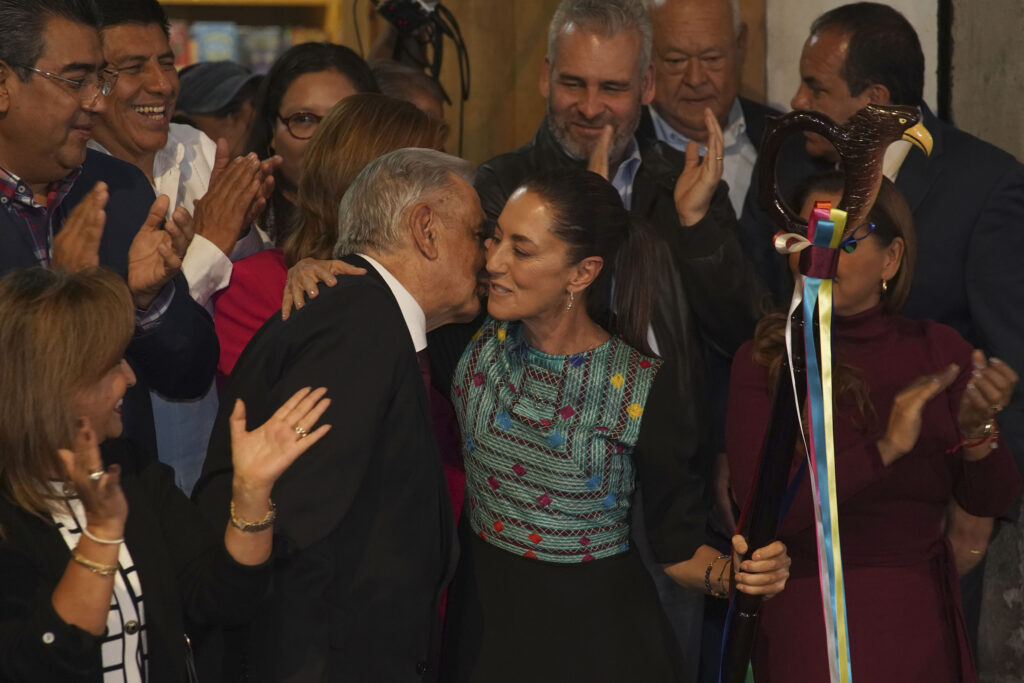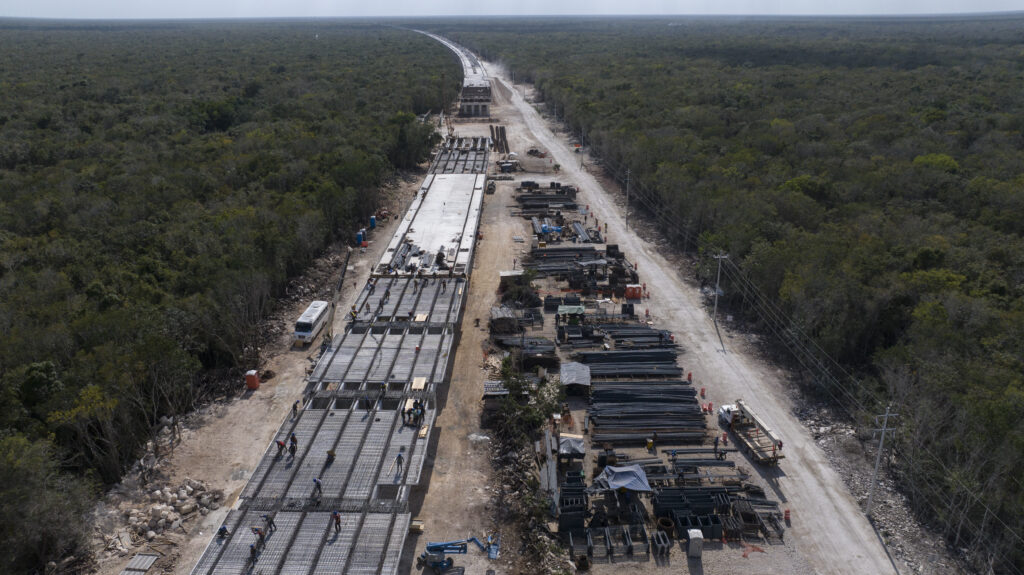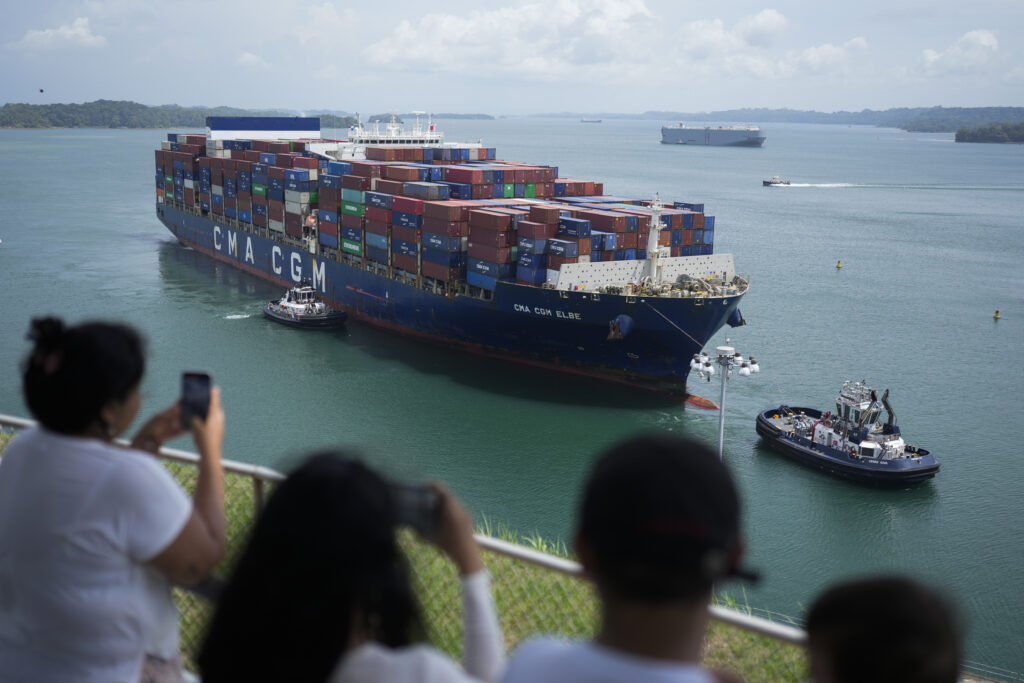Inside Mexico’s Controversial ‘Trans-Isthmus Corridor’ Megaproject
As a new president takes the reins, a global logistics hub under military control barrels ahead on the Isthmus of Tehuantepec. Mexican President Andrés Manuel López Obrador at the inauguration of a train station in Salinas Cruz in December 2023 as part of the Trans-Isthmus Corridor project. Photo courtesy of the Mexican Goverment
Mexican President Andrés Manuel López Obrador at the inauguration of a train station in Salinas Cruz in December 2023 as part of the Trans-Isthmus Corridor project. Photo courtesy of the Mexican Goverment
Claudia Sheinbaum’s victory in Mexico’s presidential election yesterday was also a victory for the outgoing president, Andrés Manuel López Obrador. Long known for her loyalty, Sheinbaum campaigned on a pledge to continue López Obrador’s policies, from signature social programs to controversial electoral reforms. But one of the most consequential policies she promises to continue is a megaproject that has mostly avoided the spotlight: the Trans-Isthmus Corridor, a massive trade and logistics zone under construction on the 200-mile-wide Isthmus of Tehuantepec.
López Obrador hinted at plans to realize the isthmus’s potential value as a trade corridor as president-elect, and included them in his National Development Plan, the guiding document of his presidential term, in July of 2019. The following year, the excavators, graters and loaders rolled out to break ground on a spate of projects: new port facilities at Salina Cruz in Oaxaca and Coatzacoalcos in Veracruz; wider highways across the isthmus; 10 tax-free industrial parks; fiber optic cables; and expanded pipelines servicing new gas plants and terminals on the Pacific coast. One revamped rail line has already been inaugurated. An expansion of existing rail links to Central America is ongoing.
If completed, the Trans-Isthmus Corridor will create a multimodal logistics route to compete with the oversaturated Panama Canal, and move the maquiladora model from the U.S.-Mexico border to the narrowest stretch of land in North America. The project is being promoted as a way to jumpstart southern Mexico’s economy by relocating overseas factories to locations closer to the U.S. market — a phenomenon known as “nearshoring.” A company in China, for example, would be able to ship subcomponents for car parts from Guangzhou to Salina Cruz, have them assembled at a nearby free trade zone and then export them directly to the Port of New York and New Jersey via Coatzacoalcos — all while enjoying deep tax breaks and fuel subsidies. “It’s similar to what we’re doing in the U.S.-border zone,” said López Obrador in 2020, before going on to list all of the tax incentives for companies looking to set up in the area.

The isthmus has been trumpeted by the Mexican government as key to unlocking economic growth and encouraging foreign investment in the country’s south, while at the same time creating a new barrier against northward migration from Central and South America.
Support for the megaproject is a political winner in Mexico. López Obrador’s approval rating hovered in the mid-60s for most of his last two years in office. And though the TIC was not completed during his term, Sheinbaum’s election means construction will continue for at least another six years. Many local mayors, politicians and businesspeople in the Isthmus region have thrown their support behind the project.
Of course, the story is not as simple as the golden tale of prosperity being spun from México’s highest office.
The Isthmus of Tehuantepec is home to 11 Indigenous nations, as well as Black and mestizo communities, who hold a significant amount of the territory under communal land title. The people of the region are known for their art, weaving, poetry, song and dance, as well as a history of collective resistance to colonialism and land theft that has allowed their languages and traditions to survive and thrive. The territory that connects the Gulf of México and the Pacific Ocean is also extremely biodiverse, with a variety of ecosystems that are home to hundreds of species of mammals, reptiles and birds.
Resistance to the project — which in recent years has taken the form of blockades, protests and legal actions — is rarely reported by the media and seldom discussed in Mexico City.
Although the federal government claims to have consulted with local communities before construction began, the process was widely considered rushed and flawed. “The López Obrador government promoted a consultation just like the ones carried out by the corrupt neoliberals, where the [process] didn’t make it down to the people who actually live in the territories,” said Carlos Sánchez, co-founder of Radio Totopo, a community radio station in the city of Juchitán, Oaxaca. “It was an express consultation. They just collected their ‘yesses’ and left in a matter of hours.”
Resistance to the project — which in recent years has taken the form of blockades, protests and legal actions — is rarely reported by the media and seldom discussed in Mexico City.
Locals say the protests are meant to draw attention to the fact they were never given the details needed to make informed decisions about the future of their territory. Attempts by communities to get information about the kind of industry and environmental impacts the megaproject will bring has already proven deadly.
The communities of the Isthmus of Tehuantepec — together with those fighting the Mayan Train, another major rail project in southern México in the hands of the Army — have shot to the top of the list of the deadliest places to be a land defender in Mexico. Official statements suggesting that resistance to the project undermines AMLO’s presidency and agenda has only worsened the situation for communities opposing the project.
“The fact that there is this stigmatization from the president, from the office of the federal executive, that’s allowed for and created a kind of legitimacy for other, less powerful officials to begin to use violence,” said Felipe Romero, a lawyer with the Mexican Center for Environmental Law . “In those two cases, that of the Mayan train and the inter-oceanic corridor, there’s been many acts of aggression against people who are defenders.” Researchers at CEMDA have documented dozens of acts of aggression against community members resisting the TIC since 2021, including three killings.

Activists are especially concerned because the TIC was placed under the direction of the Secretary of the Marines, an elite branch of the Armed Forces with close ties to Washington and a dismal human rights record. The federal government sought over $1.2 billion for the project this year, and admirals are now in charge of giving out juicy contracts, running railways and overseeing ports. A presidential decree passed last year declared the Trans-Isthmus Corridor to be of ‘national security and public interest,’ further reducing civilian oversight.
The village of Matías Romero, Oaxaca, lies 80 miles north of the Pacific coast along the trans-isthmus highway. Founded in 1906 on the eve of the Mexican Revolution as a railway town, it has long been a sleepy stop on the tracks between the Atlantic and Pacific. The community now buzzes with activity connected to railway renovation. Soon, construction of a 179-hectare industrial park that will sit at the heart of the Trans-Isthmus Corridor is expected to get underway.
During a visit to Matías Romero in May, I met with Carlos Beas Torres, the head of the Union of Indigenous Communities in the Northern Region of the Isthmus, a group founded in the 1980s to support the struggles of Zapotec and Mixe communities against powerful landowners. Sitting at a table under a thatched roof within the walled and guarded UCIZONI compound, Beas explained how an influx of state and nonstate actors has shifted the local balance of power and enforced a violent crackdown on activism.
“Power in this region in the hands of the secretary of the Marines… But organized crime has also been used as a battering ram to pressure communities to hand over their lands,” said Beas Torres. “We see organized crime as the armed wing of the state.” To illustrate, he describes a recent forced eviction of community members and land defenders in the nearby town of Mogoñé Viejo, which involved a joint operation by state police, the National Guard, the Marines and masked individuals in plainclothes.

The communities are resisting, says Beas Torres, because they do not believe attracting foreign investment will improve their living standards. They worry the loss of land for industrial parks will erode traditional foodways, reduce access to clean water and threaten cultural practices, and that the interests of large corporations will trump promises of quality public education and health care.
They also worry about the future of security and public safety. Indeed, the government vision for the isthmus — the maquilas, the militarization — conjures the specter of Mexico’s most notorious border city, Ciudad Juarez, shorthand in Mexico for extreme violence, and especially violence against women.
“This is what happened in Ciudad Juarez,” said Nisaguie Abril Flores Cruz, an activist and member of the Assembly of Indigenous Peoples in Defense of Land and Territory in the Isthmus. “I can see it coming.”
While giving me a ride to the bus station after we spoke, Beas Torres mentioned a less discussed goal of the megaproject, one he believes is shared equally by México City and Washington. “The goal is to move the border down,” he said. As his truck bumped over the railroad tracks running through Matías Romero, he pointed to the rails and said, “Welcome to Mexico.”
The idea that the Trans-Isthmus corridor could serve as a border to contain migration toward the United States might sound far-fetched. But AMLO’s national development plan describes the TIC and the Mayan Train as “curtains” that can help stem the tide of migrants heading north.
“The goal is to move the border down.”
In this vision, railway tracks and associated infrastructure would serve as a strategic choke point in the path of migrants. The government has also stated its belief that job creation in the region will encourage would-be migrants to stay put. There are already 3,000 Mexican Marines deployed along the 200-mile stretch, in addition to police and National Guardsmen.
“Controlling the U.S.-Mexico border is an epic task,” said Sergio Prieto Díaz, a researcher at the College of the South Border in Campeche and the coordinator of the Transborder Research Laboratory. “The Isthmus of Tehuantepec is the new border. There’s a train, there’s a highway, there’s a gas pipeline and other projects on the way. Trump’s border wall will get built, but not along the southern U.S. border. It is being built in southern México.”
The Isthmus of Tehuantepec has tantalized powerful men for centuries. After defeating the Aztec Empire in what is now Mexico City, the conquistador Hernán Cortés recommended to King Carlos V that the skinniest part of Mexico serve to connect the Atlantic and Pacific. Three centuries later, newly independent Mexico sought to promote a trade corridor across the Isthmus as a means of encouraging white settlement in the majority Indigenous area. After surveying the crossing at the turn of the 20th century, the U.S. opted to build a canal in Panamá. Dictator Porfirio Díaz built a train line that moved a million tons of cargo a year, but his dream of building up the isthmus collapsed with the Mexican Revolution of the 1910s.
Since then, the idea of connecting the two coasts has been floated at least eight times, according to Dr. Jaime Torres Fragoso at the Isthmus University. But only under López Obrador has everything aligned — geopolitics, the climate and the election of his protegé — to break the impasse and turn the old dreams into a reality.
Over the past year, shipping routes through Panamá have been impacted by drought, meaning less ships are passing through the country’s canal than in years previous. Other wildcards that have drawn new investment to Mexico and spurred the TIC include Houthi attacks on ships in the Red Sea, pandemic-era supply chain disruptions and shifting global trade balances. Last year, Mexico exported more goods to the U S than China for the first time in decades.

As president, AMLO demonstrated mastery in the delicate art of speaking against neoliberalism and rolling out select social programs, while also doubling down on austerity and economic orthodoxy. Six months into his term, he made a formal declaration that the neoliberal economic model had come to an end in México, and went on to announce the cancellation of the Special Economic Zones set up by his predecessor, Enrique Peña Nieto.
Just over a year later, in 2020, the free trade areas reemerged, rebranded as “Development Poles for Wellbeing” in the TIC blueprint. These free trade zones will include tax breaks for companies that set up in a gamut of strategic sectors, including semiconductors, pharmaceuticals, medical devices, electronics, car parts, renewable energy, petrochemicals, tech, machines, metals or agricultural industries.
To date, of the 10 free trade zones announced by the government, six have been granted to companies that have submitted proposals to build industrial parks. The winning bids for two industrial parks located in the port of Coatzacoalcos and a third at the port of Salina Cruz were won by the transnational infrastructure giant Mota-Engil, which is one-third owned by the China Communications Construction Company. At an International Development Bank Forum in November, Mexico’s Foreign Minister Alicia Bárcena said Amazon has already announced a commitment to invest in the industrial parks to be built in the Isthmus.
It is the expropriation of communal lands for industrial parks that’s become the most contentious part of the government’s plans in the Isthmus. Last May, the federal government purchased 331 hectares of communal land for the industrial park in San Blas Atempa. While claiming to have sought Free Prior and Informed Consent, community members vehemently deny they were properly informed. A local court agreed, granting the Zapotec community a writ of protection that stopped the project from going forward. But the ruling did nothing to protect the residents of Puente Madera from the state crackdown that followed.
In February, local activist David Hernández Salazar — who was criminalized along with 17 other members of his community — was sentenced to 46 and a half years in prison for opposing the free trade area in San Blas Atempa. The arson and intentional injury charges against Hernández Salazar were brought by the Municipality of San Blas Atempa and the National Agrarian Registry and concerned events at which he was not present.
To date, at least 55 Isthmus residents, most of them Indigenous, are facing criminal charges as a consequence of their opposition to the project.
On July 4 of last year, the body of a member of the Mixtequilla Civil Resistance named Noel López Gallegos was found in a vacant lot in Santa María Mixtequilla. According to a report from CEMDA, he was targeted for his work opposing the expropriation of over 500 hectares of communal land, and seeking accountability for land payments. Nine of López Gallegos’ MCR colleagues were arrested in January when the Zapotec town was flooded with Marines, police, National Guard and soldiers. One of them, Adelaido López Gallegos, was jailed until being released last week after a federal judge threw out the charges against him. To date, at least 55 Isthmus residents, most of them Indigenous, are facing criminal charges as a consequence of their opposition to the project.
Frustrated with tallying attacks against defenders, Loni Hensler, co-coordinator with the Veracruz-based group Diverse Territories for Life, last summer toured the isthmus with a delegation representing 23 civil society organizations. During three days of visits to five communities in the path of the corridor, she says the group was followed and photographed by members of the Mexican Marines, in what they interpreted as acts of intimidation.
“It made us wonder,” said Hensler. “If that’s how an observer mission is treated, what is the climate like for local land defenders?”
Your support is crucial...As we navigate an uncertain 2025, with a new administration questioning press freedoms, the risks are clear: our ability to report freely is under threat.
Your tax-deductible donation enables us to dig deeper, delivering fearless investigative reporting and analysis that exposes the reality beneath the headlines — without compromise.
Now is the time to take action. Stand with our courageous journalists. Donate today to protect a free press, uphold democracy and uncover the stories that need to be told.





You need to be a supporter to comment.
There are currently no responses to this article.
Be the first to respond.